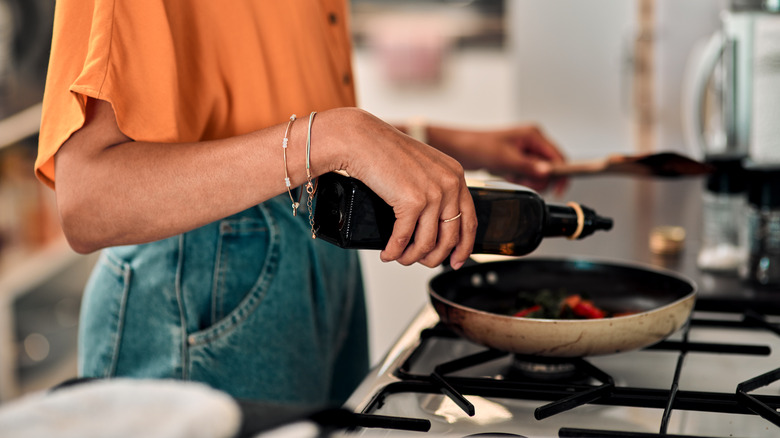
Peopleimages/Getty Images
It’s an indispensable ingredient in any kitchen, but the ins and outs of buying and using olive oil can be multifaceted. When it comes to cooking with the stuff, there are definitely some recommendations to keep in mind for optimal results. Most supermarkets carry a wide variety of olive oils, and some are better suited for specific purposes over others. Meanwhile, different cooking techniques call for a range of ingredients.
To get to the bottom of it, we reached out to some olive oil experts for advice. Chef Eric Bartle and Sara Kundelius, Culinary Directors at Durant Vineyards and Olive Mill in Dayton, Oregon, offered plenty of tips for cooking with olive oil. Meanwhile, Nasser Abufarha, CEO of Canaan Palestine, a company that sources organic olive oil from small farms in Palestine, had lots of input to share. Finally, Cherilee Dick, owner of Victoria Olive Oil Co. in British Columbia, Canada, divulged some top tips.
Cooking with olive oil should be part of your routine, and it doesn’t have to be complicated, but there are common mistakes that can ruin the whole experience. With this list that’s packed with straightforward and easy-to-execute tips you’ll avoid any mistakes that could plague your dish. Read on for advice on cooking with olive oil.
Not paying attention to the type of olive oil

Elena_Alex_Ferns/Shutterstock
Obviously, olive oil is made with olives, but it’s a little more complex than that. As Nasser Abufarha notes, “There are so many variations to extra virgin olive oil depending on the type of olives, where they are grown, and how and when the olives are harvested.” About 150 varieties of olives can be used to produce the oil, and the flavor variations can vary pretty widely in turn. For example, the oil may be fruity, grassy, mild, or bitter, depending on several factors.
While these characteristics won’t be as noticeable as the oil heats during the cooking process, they can still steer the direction of flavors your dish takes on. For example, Sara Kundelius shares, “the more assertive oils, like Koroneiki and Mission are preferred for baking, as [I] really want the olive oil flavor to not be lost in a cake or cookie, as sugar naturally counterbalances the bitter notes of extra virgin olive oil.”
On the other hand, if you’re sauteing vegetables, subtle nuances of the sort are less noticeable. Cherilee Dick recommends, “Mild [olive oil] is great if you don’t want a pepper or bitter finish to your dishes.” Indeed, if you’re already using bitter ingredients in your recipe, you might want to opt for olive oil made with a fruitier variety of olives, such as Arbequina or Cerignola.
Not using a thermometer
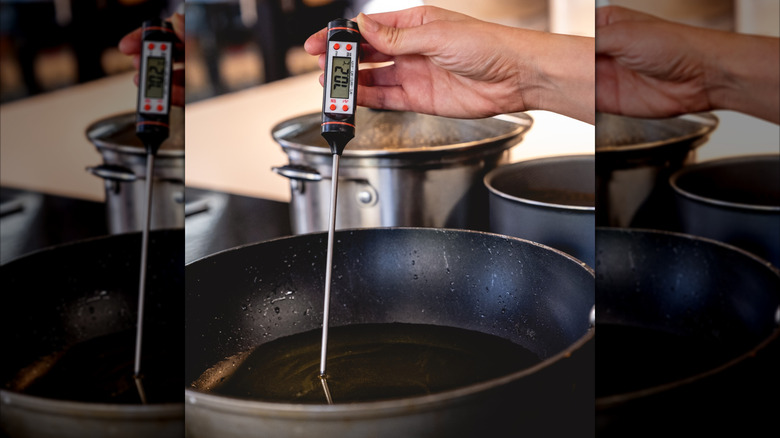
Samuel Ponce/Shutterstock
“Temperature matters when cooking with olive oil to maximize the taste and protect the oil’s structure to get its health benefits,” Nasser Abufarha explains. Using a thermometer allows you to remain below olive oil’s smoke point, the temperature at which it starts to burn. Although people tend to steer clear of using olive oil for high-heat applications, it actually has a relatively high smoke point of 410 degrees Fahrenheit. Consequently, you can use it for sauteing, stir-frying, and even deep-frying.
It’s a common myth that you can’t cook with olive oil at high heat, but as long as you’re below 410 degrees Fahrenheit, then you’re in the clear. For this reason, Eric Bartle highlights, “A good digital thermometer will really help the home cook achieve success!” Meanwhile, Abufarha points out, “In general, extra virgin olive oil is actually the most stable oil to cook with, and even if heated past its smoke point, it produces low levels of harmful compounds due to its high antioxidant content.” To avoid creating any undesirable compounds, be sure to test the temperature of the oil as it heats.
Always using the same ratio of olive oil
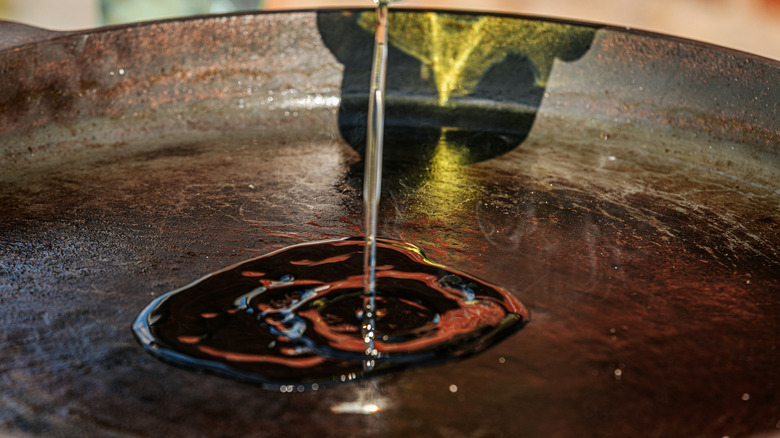
Emvat Mosakovskis/Shutterstock
It’s important to use the right amount of olive oil when cooking, or you’ll end up wasting it or using it pointlessly. Too much and it’ll sit in the pan; not enough and it’ll just cook off, and you might as well not have used it in the first place. As Nasser Abufarha explains, it ultimately comes down to what you’re making. To illustrate, he describes, “For example, when cooking in a skillet, you will need to use just enough oil to fully coat the entire bottom. That’s typically 1 to 2 tablespoons, depending on the size of your skillet.”
Meanwhile, other types of cooking might require a little more. “If you are pan-frying, use a generous amount of olive oil on medium-high heat to get the rich olive oil flavor in your dish,” Abufarha says. Similarly, he notes that roasting or marinating requires a suitable amount of oil too, in order to infuse the other ingredients with flavor and prevent them from drying out as they cook.
Using top quality olive oil to cook

lev radin/Shutterstock
It’s understandable to want to seek out the highest quality ingredients for your home cooking, but going all out on your olive oil purchase should be reserved for specific purposes. As Eric Bartle explains, “a top quality olive oil and its flavor nuances (tomato leaf, green pepper, black pepper, fresh cut grass, etc.) really is best appreciated when used raw as a finishing oil to garnish.” Nasser Abufarha agrees and highlights the fact that when used as a garnish, “its complex range of flavors are on full display.”
On the other hand, cooking mutes some of the flavor nuances of olive oil, reducing the range of aromas that can be tasted. Bartle also points out, “When cooking, the addition of more and more ingredients will tend to cover up those flavors.” For optimal balance, Abufarha recommends cooking with an olive oil that has a rounder flavor profile, in order to benefit from the nutritional qualities and enhance your recipe.
That said, if you want to maintain maximum health benefits, Cherilee Dick suggests looking for an olive oil that has a higher biophenol content (the antioxidants responsible for EVOO’s purported health benefits), since heating it will reduce the amount. Biophenols can be lab tested, but at home you can identify them by their peppery, bitter taste. Consequently, cooking with olive oils that are a little bolder tasting will help ensure more of the beneficial properties are retained.
Treating it like a special occasion ingredient
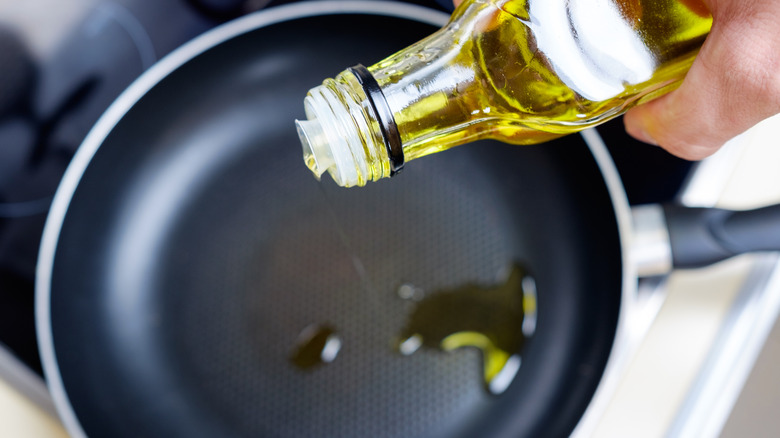
Filistimlyanin/Getty Images
Extra virgin olive oil tends to come with a higher price tag than, say, vegetable oil, but its unique characteristics are worth it. Whether you’re seeking health benefits from the higher antioxidant content, or a rich taste from its complex flavor profile, EVOO does the trick. Eric Bartle thinks that consumers tend to use it too minimally, noting, “Because of its higher price point than mass produced seed oils or inferior olive oils, there’s a tendency to covet the good olive oil and ‘save it’ for special occasions.”
You might skimp and use just a drizzle at service or barely coat your skillet, but to properly incorporate olive oil into your cooking, be generous. Bartle adds, “The health benefits can only be had if you’re consuming it regularly, and as a chef, I think life is too short to not eat deliciously as much as possible!”
That said, you don’t have to allocate your entire grocery budget to olive oil. Nasser Abufarha thinks the biggest mistake people make when shopping for olive oil is that “[They] tend to choose what they think is the best based on budget or quality without thinking through what they are using it for.” When it comes to cooking with olive oil, you don’t need to go for the priciest limited edition bottle made with single estate olives — but you also want to make sure it’s a quality product that will retain its characteristics and endure some heat if you plan to cook with it.
Using olive oil past its prime
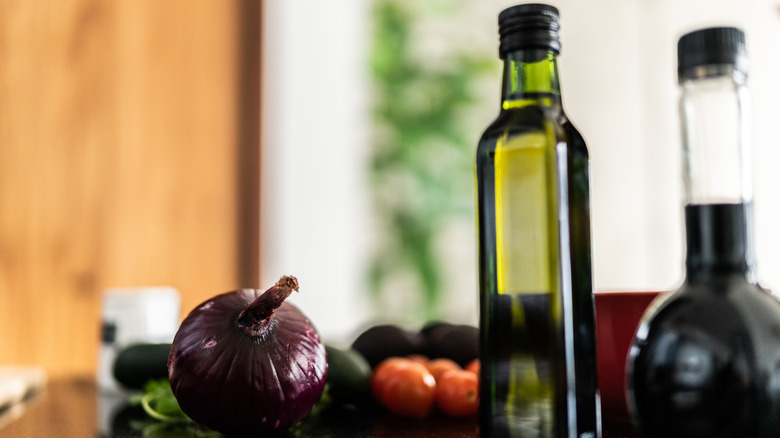
Fg Trade Latin/Getty Images
Any home cook is only as good as their ingredients, and freshness is a key factor when it comes to olive oil. If you’re using it liberally in your cooking and garnishing, chances are you’re making your way through a bottle of EVOO before it’s past its prime. On the other hand, if you’re restricting your use or you purchase it in large formats, you may want to check the best-before date. Since extra virgin olive oil is made without additives, it has to be consumed more quickly than highly refined oils. Sealed, it should last about 12 to 18 months, but once the container is open, you’ll want to finish it within three to six months.
Although expired olive oil won’t have the same unpleasant aspect as something more perishable, like milk, it won’t be in its optimal state. It will become rancid as it oxidizes, affecting the flavors and causing it to be more bitter and acidic. If you use it to cook, you’ll throw off the flavors in your dish and reduce the health benefits. To maintain its shelf life, be sure to keep your EVOO in a cool, dark location, and move it near the stove only when it’s time to cook with it.


Dining and Cooking